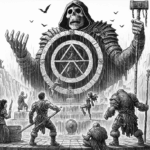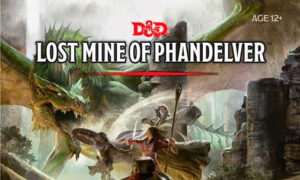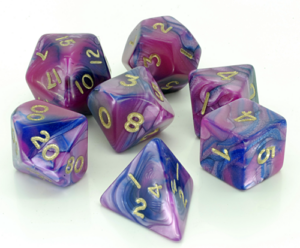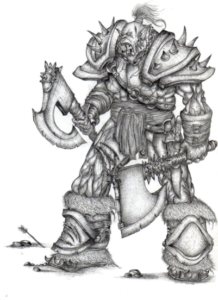
How to play
There are two ways to play Pirate’s Dice. In one, each player has five standard 6-sided dice, and in the second, all players share a single “hand” of five dice that is passed around the table. We’ll describe each version and a few variants for each.
The game is played over multiple rounds. The first player for the first round is determined by mutual agreement or by all players rolling two dice, with the highest roller becoming the first player. Play then proceeds clockwise around the table.
To begin each round, all players roll their dice simultaneously. Each player looks at their own dice after they roll, keeping them hidden from the other players. (If any dice has landed on top of another, the player must roll all their dice again.)
The first player then states a bid consisting of a face (“1’s”, “5’s”, etc.) and a quantity. The quantity represents the player’s guess as to how many of each face have been rolled by all the players at the table, including themselves. For example, a player might bid “five 2’s.”
Each subsequent player can either then make a higher bid of the same face (e.g., “six 2’s”), or they can challenge the previous bid. (Note that there are a large variety of bidding variations that can be used. We’ll describe some of them below.)
Challenge
If the player challenges the previous bid, all players reveal their dice. If the bid is matched or exceeded, the bidder wins. Otherwise, the challenger wins.
Winning
If the bidder loses, they remove one of their dice from the game by placing it in front of their dice cup.
The loser of the previous round begins the next round.
Optional Rule: Sudden Death
In the event that the game comes down to two players with only a single dice each, bids are then made on the sum of both dice instead of the quantity of faces rolled.
Example of play:
Bob, Lauren, Steve and John are playing a game of Pirate’s Dice. Bob is the first player. After they have all rolled and looked at their own dice, Bob begins by bidding “three 4’s.”
Play passes to Lauren, who makes a higher bid of “five 4’s.”
Play passes to Steve who bids “seven 4’s.”
Play passes to John, who challenges Steve’s bid. Because the bid has been challenged, all players lift their dice cups to reveal their dice. There are six 4’s showing, so John wins because Steve’s bid was not matched or exceeded. Steve would have won if there had been seven or more 4’s showing.
Because he lost the round, Steve takes one of his five dice and places it in front of his dice cup. It will not be used for the remainder of the game.
Source: DiceDepot and Wikipedia
Discover more from Cresthaven RPG
Subscribe to get the latest posts sent to your email.













